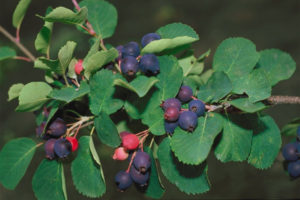 (“Juneberries.” Eat The Weeds, www.eattheweeds.com/amelanchier-arborea-busting-out-all-over-2/.) |
|||||
|---|---|---|---|---|---|
| Common Name(s) | Shadbush, Juneberry, Serviceberry | ||||
| Scientific Name | Amelanchier canadensis | ||||
| Family | Rosaceae | ||||
| Location/Vegetative Zone | Wet sites, bogs, swamps | ||||
| Flowering Period | April-May | ||||
| Identifying Characteristics | shrub/tree about 0.5–8 m tall | ||||
Description
- Deciduous shrub or small tree.
- Grows 0.5–8 m tall
- Leaves
- Alternate, simple, ovate to ovate-oblong
- Serrated margin
- 1–5.5 cm long and 1.8–2.8 cm broad
- Light to dark green, matte
- Change to orange-red in fall
- Flowers
- 5 white petals
- Each raceme has four to ten flowers
- Slightly fragrant
- Blooms in early spring (April to May)
- Fertilizes in early summer
- Fruit is a pome, 7–10 mm diameter
- Fruit is round, green berry; turn dark purple when ripe
- Fruit is edible and sweet when ripe
- Bark
- gray-silver bark
- striped
- glabrous, young stems
- small lenticels
- imbricate buds, conical in shape
- buds are reddish purple
- Habitat:
- Wet sites, bogs, and swamps
- Easily grown in average, medium, well-drained soil
- Likes full sun to part shade
- Tolerant of a wide range of soils
- Eastern North America; from Maine south to Alabama
Medicinal/Edible Uses
- Dried, used as an herb, infused into oils/vinegars, etc.
- Fruit
- Dried and used to make pies, jams, jellies, etc.
- Bark
- Infused into tea to treat gynecological and dysentery
- Can be used as a bath for children and worms
- Inner bark can be used in a disinfectant
- Infused into tea to treat gynecological and dysentery
Cultural Uses
- Native Americans: used wood to create arrow shafts and armor
- Whole plant used ornamentally and for bonsais
Sources
Christianson, John. “Juneberries”. North Dakota State University. University Relations. N.d. Web.
“Medicinal Herbs: Juneberry”. Natural Medicinal Herbs. Spiritual Knowledge, Led Ziarovky. N.d. Web.
2,429 total views, 2 views today
